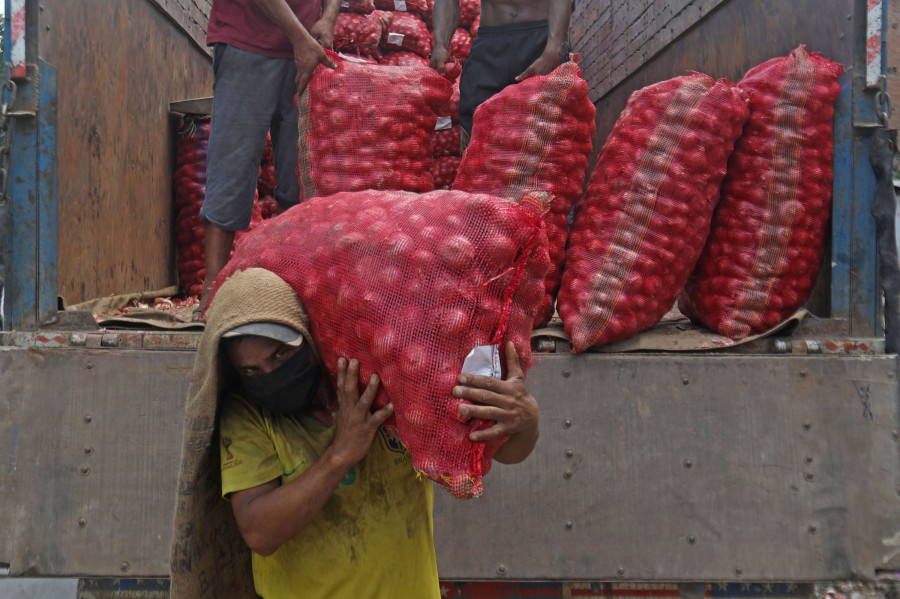Money
Onion prices refuse to drop despite imports from China
Wholesalers at the Kalimati Fruits and Vegetable Market are charging Rs130 per kg for Chinese onions and Rs135 per kg for the Indian product.
Krishana Prasain
Nepali traders are sourcing onions from China as India continues to bar exports of the staple vegetable, but there is no respite for consumers as they still have to pay five times more than usual for the product, whether imported legally from the north or smuggled in from the south.
On Thursday, wholesalers at the Kalimati Fruits and Vegetable Market were charging Rs130 per kg for Chinese onions and Rs135 per kg for the Indian product.
The retail price of onions is Rs150-160 per kg, said traders. In normal times, you could buy the pungent bulbs for Rs30 per kg. According to traders, high transportation costs make the Chinese product dear.
Traders said they had placed orders for tonnes of onions from the northern neighbour for the Dashain festival, but the shipments were stranded at the border due to landslides and virus-triggered movement restrictions.
Bhanu Bhakta Upreti, a potato and onion trader at the Kalimati Fruits and Vegetable Market, said the trucks bringing Chinese onions arrived in Kathmandu from the Tatopani border point only a month later.
The northern border, which is prone to opening and closing intermittently for a variety of causes, re-opened on Wednesday.
“It costs nearly Rs100,000 in freight charges to transport a truckload of onions from the Tatopani border point to Kathmandu. As a result, prices have gone up,” Upreti told the Post.
Chinese dried onions started arriving at the Kalimati Fruits and Vegetable Market on Wednesday when around 14 tonnes were delivered. A truckload of onions is 14 to 15 tonnes, Upreti said.
On September 14, the Directorate General of Foreign Trade, India issued a notice announcing an export ban on all varieties of onion with immediate effect. The ban came six months after an earlier embargo was lifted in March.
Despite the official ban, onions have been arriving illegally in small quantities across the southern border. “The small amounts of contraband onions that slip through the border fulfil current needs. There aren't many buyers because of the high price, and commercial users like restaurants and hotels remain shuttered,” said Upreti.
The Kathmandu Valley consumes 20,000 kilos of onions daily, he said.
Chinese dried onions, which are bigger in size, have a high water content compared to Indian onions due to which consumers prefer Indian onions, said Upreti. “Even though Chinese onions are cheaper, people prefer Indian onions because they taste better,” he said.
Traders said they had ordered around 180 tonnes of Chinese onions to meet festive demand.
India's export ban on onions has opened new opportunities for importers of the Chinese product as the stoppage sent prices soaring. Following the ban last year, retail prices had jumped on short supply, hitting up to Rs250 per kg during the festival season.
Resham Tamang, administrator at the Balkhu Agriculture Vegetable Market, said that onion prices would not rise further following the arrival of fresh shipments from China. “The market is expected to be flooded with Chinese onions once transportation resumes,” he said.
The ban on exports from India, one of the largest producers and exporters of the vegetable in South Asia, has caused distress to Nepali households amid the festival season when its consumption swells. Many families are eating less onions due to the high prices, traders said.
Onions are a staple in South Asian cooking. Countries such as Bangladesh, Nepal, Malaysia and Sri Lanka rely on supply from India. Nepal is almost totally dependent on onion shipments from India as domestic production is negligible.
India outlawed exporting onions following a shortage due to excessive rainfall in the southern states of Karnataka and Andhra Pradesh which damaged the summer-sown crop and delayed harvesting in other states.




 15.12°C Kathmandu
15.12°C Kathmandu















